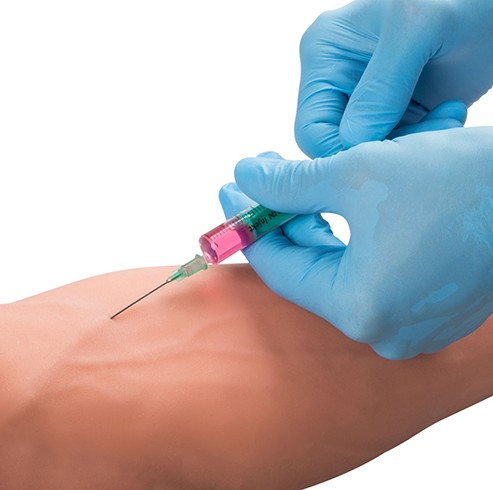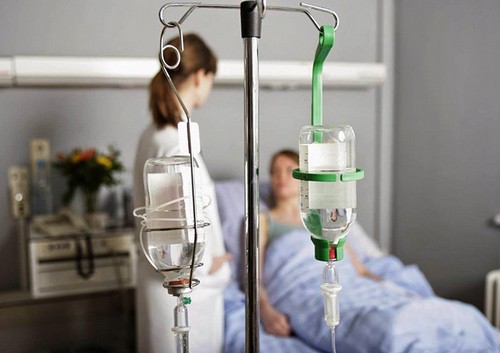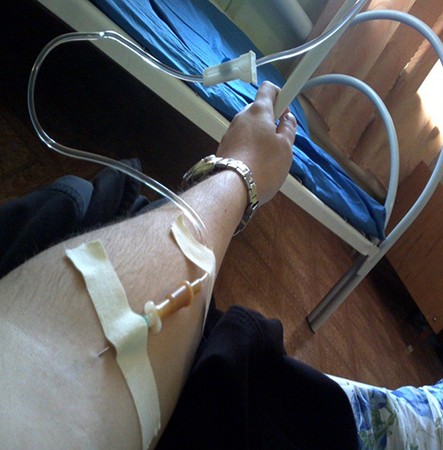If the first 3 methods are quite accessible for independent execution, then intravenous infusions are preferably performed in a hospital facility.
Unlike an intramuscular injection, drug delivery to the blood occurs instantly. The therapeutic effect is observed almost instantly, which is especially valuable when providing emergency care.
Some varieties of drugs are irritating to muscle tissue, so you can enter them only intravenously.
The supply of drugs to the body through a vein can be carried out in two ways, which differ in the duration of the procedure:
- Thin stream.
- Drops.
The essence of modern drug treatment is to supply the necessary drugs to the body.
Delivery can be carried out in several ways:
- Tablets.
- Rectal enema.
- Intramuscular injection.
- Intravenous infusion.
Intravenous injection

In particular, these drugs include:
- Calcium chloride.
- Argeferre.
- Likferr.
- Albumen.
Some drugs intended for intravenous administration must be diluted with saline. The delivery of the drug in its pure form to the body threatens with serious complications – from anaphylactic shock to cardiac arrest. The syringe is filled in 2 doses : first, medicine, then saline. This helps to mix the components better.
Before injection, a tourniquet is placed on the arm above the elbow joint. Patting on the hand and working with the hand improves the filling of the vein and its visibility. After fixing the vein with a finger, a needle is inserted at an angle of 20º. A sign that the needle has entered a vein is the appearance of blood in the syringe when the piston is pulled back.
The drug enters the bloodstream through an injection needle. The procedure for its introduction into the vein of professional skills. The slightest violation, which even an experienced specialist can allow, leads to undesirable consequences – the formation of a hematoma or thrombus. The procedure is performed within a few minutes to prevent an excessively high concentration of the drug in the blood.
Dropper
A dropper is a system consisting of a transparent reservoir mounted on a rack and a plastic tube bounded by two metal needles. The first needle is inserted into the reservoir with the drug, the second serves to transport the drug into the vein. The container with the medicine is placed at a height of about 1.5 m above the floor so that the treatment solution flows by gravity. The dripping speed depends on the drug and is regulated by a special valve.

With the help of a dropper, drugs are introduced into the blood in emergency cases:
- Antibiotics for pneumonia.
- Thrombolytics with the threat of myocardial infarction.
- Chemotherapy for cancer.
- Rapid elimination of toxins from the body during alcohol poisoning and the massive exposure to toxic substances.
- Recovery of vitality after serious illness.
In addition, droppers perform the following functions:
- Restorative normalize pressure, restore the function of internal organs.
- Cholesterol actively restore lipid balance.
- Antianemic drugs include a complex of iron preparations in combination with general strengthening. They help improve blood composition and restore metabolism.
- Cosmetology – due to the balanced composition of drugs, the appearance and general condition of the patient improves.
With all the undoubted advantages of a dropper, there are also a number of drawbacks that limit their scope. The main disadvantage of intravenous infusions is the likelihood of blood clots, especially with prolonged procedures.
The current position of doctors regarding intravenous infusions is such that they need to be done only in case of urgent need. As the patient’s condition stabilizes, injections into the vein are canceled and replaced by intramuscular injections or tablets. The circulation time of the drug in the body is determined only by its composition, regardless of the form of admission.
What is common in these procedures?
All types of intravenous infusions require strict observance of the rules of antiseptics.
Required:
- Hand washing and treatment of the skin of the patient.
- Antiseptic treatment of the ampoule with the medicine.
- The use of disposable tools, in extreme cases, sterilization.
The technique for introducing a needle is the same for any type of infusion of a drug into a vein. For procedures, it is more convenient to use the vein of the ulnar fossa. It has a relatively large diameter, is located close to the surface layer of the skin and is quite static in its position.

What is the difference
- After injections, the effect is observed for 10 minutes. With infusion therapy, the result is somewhat slower.
- The intravenous injection procedure is completely controlled by a medical professional. The dropper is placed for a long time, most of which the patient spends alone, so the needle should be clearly fixed in the vein in order to avoid its puncture and the appearance of hematomas.
- Upon receipt of the drug in the body, a response may occur. With infusion therapy, the body’s reaction will be less pronounced, which will help to avoid side effects.
When and which procedure is best to use
A dropper is preferable in some cases:
- With a large amount of the drug introduced into the body. With a syringe, you can enter no more than 10 ml.
- When it is required to create an optimal concentration of a medicinal substance in the blood and maintain it for a certain period of time to consolidate the therapeutic effect. The therapeutic substance, injected jet, quickly disintegrates in the bloodstream.
- With the introduction of a large volume of fluid into the body for medicinal purposes. Such situations arise in cases of blood loss, dehydration, imbalance of water-salt balance, as well as liver and kidney functions.
- If the drug cannot be absorbed through the gastrointestinal tract.
- The introduction of nutrients through a vein. This situation develops after surgery on the stomach or intestines.
Special care should be taken with droppers in old age.
It is more difficult for an old body to cope with an excess of infused fluid.
The most common complications after infusion therapy:
- Renal failure.
- Myocardial infarction.
- Hypertensive crisis.
- Overhydration.
- Pulmonary edema, brain.



